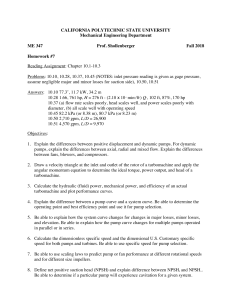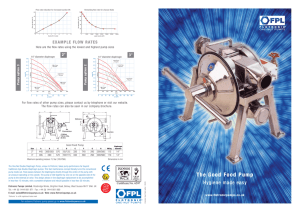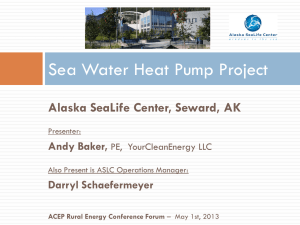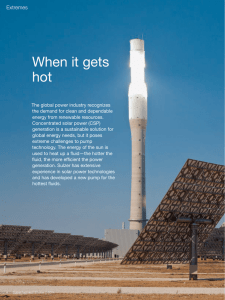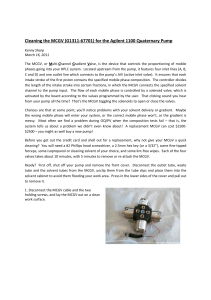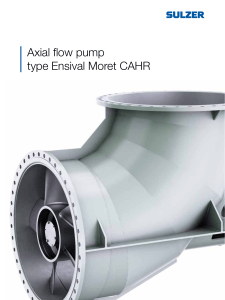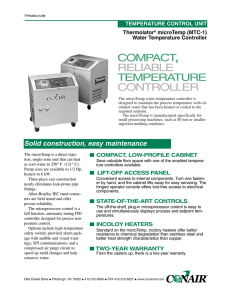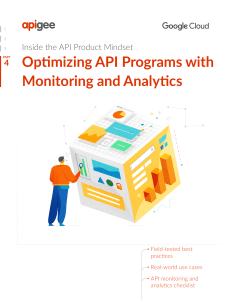API 610 12th Edition Highlights: Centrifugal Pumps
Anuncio
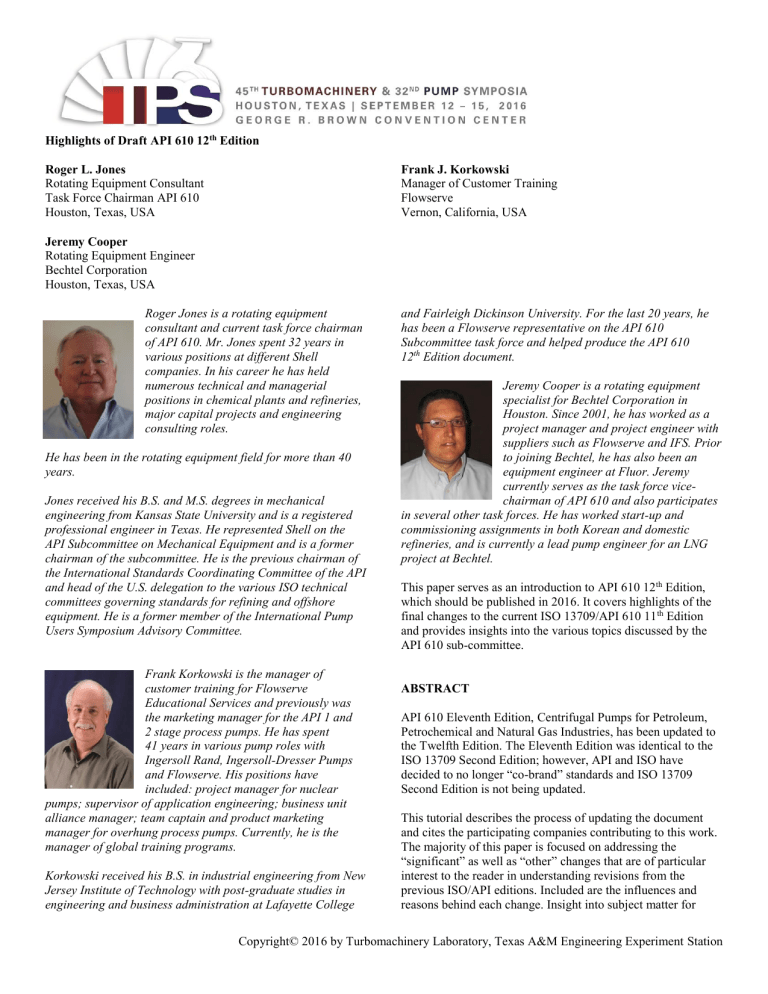
Highlights of Draft API 610 12th Edition Roger L. Jones Rotating Equipment Consultant Task Force Chairman API 610 Houston, Texas, USA Frank J. Korkowski Manager of Customer Training Flowserve Vernon, California, USA Jeremy Cooper Rotating Equipment Engineer Bechtel Corporation Houston, Texas, USA Roger Jones is a rotating equipment consultant and current task force chairman of API 610. Mr. Jones spent 32 years in various positions at different Shell companies. In his career he has held numerous technical and managerial positions in chemical plants and refineries, major capital projects and engineering consulting roles. He has been in the rotating equipment field for more than 40 years. Jones received his B.S. and M.S. degrees in mechanical engineering from Kansas State University and is a registered professional engineer in Texas. He represented Shell on the API Subcommittee on Mechanical Equipment and is a former chairman of the subcommittee. He is the previous chairman of the International Standards Coordinating Committee of the API and head of the U.S. delegation to the various ISO technical committees governing standards for refining and offshore equipment. He is a former member of the International Pump Users Symposium Advisory Committee. Frank Korkowski is the manager of customer training for Flowserve Educational Services and previously was the marketing manager for the API 1 and 2 stage process pumps. He has spent 41 years in various pump roles with Ingersoll Rand, Ingersoll-Dresser Pumps and Flowserve. His positions have included: project manager for nuclear pumps; supervisor of application engineering; business unit alliance manager; team captain and product marketing manager for overhung process pumps. Currently, he is the manager of global training programs. Korkowski received his B.S. in industrial engineering from New Jersey Institute of Technology with post-graduate studies in engineering and business administration at Lafayette College and Fairleigh Dickinson University. For the last 20 years, he has been a Flowserve representative on the API 610 Subcommittee task force and helped produce the API 610 12th Edition document. Jeremy Cooper is a rotating equipment specialist for Bechtel Corporation in Houston. Since 2001, he has worked as a project manager and project engineer with suppliers such as Flowserve and IFS. Prior to joining Bechtel, he has also been an equipment engineer at Fluor. Jeremy currently serves as the task force vicechairman of API 610 and also participates in several other task forces. He has worked start-up and commissioning assignments in both Korean and domestic refineries, and is currently a lead pump engineer for an LNG project at Bechtel. This paper serves as an introduction to API 610 12 th Edition, which should be published in 2016. It covers highlights of the final changes to the current ISO 13709/API 610 11 th Edition and provides insights into the various topics discussed by the API 610 sub-committee. ABSTRACT API 610 Eleventh Edition, Centrifugal Pumps for Petroleum, Petrochemical and Natural Gas Industries, has been updated to the Twelfth Edition. The Eleventh Edition was identical to the ISO 13709 Second Edition; however, API and ISO have decided to no longer “co-brand” standards and ISO 13709 Second Edition is not being updated. This tutorial describes the process of updating the document and cites the participating companies contributing to this work. The majority of this paper is focused on addressing the “significant” as well as “other” changes that are of particular interest to the reader in understanding revisions from the previous ISO/API editions. Included are the influences and reasons behind each change. Insight into subject matter for Copyright© 2016 by Turbomachinery Laboratory, Texas A&M Engineering Experiment Station future updates to ISO 13709/API 610 is addressed at the end. One area of particular interest in the Eleventh Edition was the data sheet program which had been improved and was expected to support Electronic Data Exchange (EDE) for engineering contractors, end users and pump manufacturers. These expectations to save significant effort in accurately specifying equipment requirements have not been met. And so in the Twelfth Edition, a task force sub-group is trying to further enhance its use. INTRODUCTION The American Petroleum Institute (API) publication “Centrifugal Pumps for Petroleum, Petrochemical and Natural Gas Industries, 11th Edition, September 2010 is being updated to the 12th Edition. The 12th Edition first draft was issued for comment and then reviewed by the API Subcommittee on Mechanical Equipment (SOME) at the 2014 Fall Refining Meeting in November. The second draft was balloted in the first quarter of 2016 and published later in 2016. A normal, required part of the update process is to compare the previous edition with the current edition of the “standard paragraphs”, i.e., an API document which applies to all API standards. This was accomplished by dividing the document into sections and tasking sub-team members to read two sections. No two sections were read by the same two-team members. In this edition, the sub-team was also tasked with looking for sections that were illogically organized. These would be reorganized for improved reading in the Twelfth Edition. Several sections such as bearings and bearing housings have been substantially reorganized, so they may appear unfamiliar to users of the Eleventh Edition, even though there is very little change technically. As one can see from the chronology in Table 1, publication of a standard takes considerable time. If the 610 schedule is met, the standard should be published very close to the target five-year interval between new editions. Historically, the revision process has often been very slow. It is believed that API 610 has never been reaffirmed to schedule. (Within the API process, reaffirmation grants a two-year delay before the next publication is due.) Yet, the interval between 610 editions is still average. Table 1 provides some interesting historical data on the various API 610 Editions. Table 1: API 610 documents historical data TASK FORCE FORMATION AND OBJECTIVES Numerous companies have provided experts in their fields to produce this updated document. Engineering contractors, end users and pump manufacturers alike comprised an international team to explore, discuss and debate a variety of topics. The following companies and a number of private consultants contributed to this work: Bechtel, Fluor, KBR, Shell, Petrobras, Aramco, Dow, Union, CPC, Flowserve, Floway, ITT-Goulds, Ruhrpumpen, Sulzer, Sunstrand, Weir, DuPont, Hydro, Nuovo Pignone, ABS Pumps, European Sealing and Intelliquip. This API 610 task force is led by its chairman, Roger Jones; vice-chair Jeremy Cooper of Bechtel; and secretary, Paul Behnke of ITT Goulds. Copyright© 2016 by Turbomachinery Laboratory, Texas A&M Engineering Experiment Station THE UPDATE PROCESS API standards are on a five-year review cycle. Thus, approximately three years after a standard has been published, a task force is reformed to review the current standard and determine: If it requires updating to conform with current technology and market practices; or Whether it can be reaffirmed Presuming the decision is to revise the standard, the task force proceeds to: determine how best to accomplish the updating work; make committee assignments; and recommend proposed changes. All changes must meet with task force approval before they are included in the first draft of the revised standard. During the review process, the task force must consider all standard paragraphs that are pertinent to the standard and either: 1. 2. 3. Change the standard to agree with the standard paragraph; or Modify the standard paragraph to better suit the standard being reviewed; or Justify that the standard paragraph does not apply to the equipment for which the standard being reviewed applies, thus and remove it When the task force is satisfied that the revised standard is ready, the draft standard is submitted to API for distribution to member companies for comment. In the case of the 12th Edition, more than 500 comments were received. Comments may be technical or editorial. Once the comments are received, the chair, vice chair and secretary prepare proposed “resolutions” to each comment. At this point, the proposed resolutions are presented to the task force. They then discuss the resolutions and decide on the wording that will become the “presentation draft”. The “presentation draft” is submitted to the Subcommittee on Mechanical Equipment (SOME). In the case of the 12 th Edition draft, the submittal occurred at the Fall Refining Meeting. All comments to the standard were presented, explained and/or justified. At this time, the sub-committee may request changes be made to the draft or that the task force revisit certain subjects and present them again. For the 12 th Edition, a number of changes were requested and most changes were addressed at the end of December 2014 with final resolution by December 2015. The document was then sent to API for editing, in first quarter 2016. Once the API editing has been completed, the task force subteam reviewed the entire standard until they are satisfied. The revised draft 12th Edition standard was then submitted to API headquarters for balloting by all voting members of the American Petroleum Institute. All negative ballots must be resolved before the revised standard can be published. The balloting process usually takes about one to six months, while the entire process usually takes between two and four years, depending on the magnitude of the changes. SIGNIFICANT ADDITIONS AND CHANGES The API 610 sub-committee started the process of reviewing about 30 items based on inputs from the SOME, industry leaders, updates from referenced specifications (such as Hydraulic Institute) and subcommittee members. The first draft resulted in the submissions of about 300 technical comments along with 200 required minor edits. The key additional or modified items recommended for the Twelfth Edition inclusion are as follows: 1. 2. 3. 4. 5. 6. 7. 8. 9. 10. 11. 12. 13. 14. Addition of shaft guards for all pumps New Informative Annex addressing “Special Purpose Centrifugal Pumps” which includes high-energy pumps Inclusion of recommended practice API RP 691 “Risk Based Machinery Management” Material Columns reduction and improvements to material designations, including non-metallics Updated Annexes for Material class selection guidelines and Material columns Energy density limits for pipeline pumps Performance test points modification Clarification of several definitions and images Re-arrangement of certain sections Addition of “data list”; data sheet update Pressure ratings for OH, BB1 and BB2 pumps VFD considerations Vertical pumps: TIR on vertical motor mounting flange; can requirements; dynamics Updated all paragraph numbers, tables SHAFT GUARDS The current API 610 11th Edition addresses only coupling guards. Inputs from multiple refineries indicated that safety organizations were pointing out that the area between the pump casing cover and the bearing housing has an exposed shaft area that should be covered. More specifically, this is the shaft area where the mechanical seal gland is located. Furthermore, the drive collar adjacent to the cartridge seal has set screws, which could be a concern if someone placed their hand in that area during pump operation. The sub-committee decided to mandate a shaft guard. A simple decision became complicated, however, as we started to define the guard requirements. Basically, the same requirements which apply to coupling guards pertain to Copyright© 2016 by Turbomachinery Laboratory, Texas A&M Engineering Experiment Station shaft guards, although with some differences. Unlike the coupling guard, woven wire is an acceptable approach, since this guard does not have the need to be sufficiently stiff (rigid) to withstand a 200 lb-f (900 N) static point load. The shaft guard, however, does require to be sufficiently vented to prevent accumulation of seal emissions, liquid or vapor. An opening of 0.50 inch (1.27 cm) in diameter has been specified to allow for a portable VOC emission probe 0.25 inch (0.64 cm) in diameter to measure emissions within 0.39 inch (1 cm) of the shaft-seal interface area. Further information was provided for pipeline pumps. pressure boiler feed water pumps; and even possibly un-spared 3 to 4 MW refinery charge pumps. It is recognized that special purpose pumps constitute only about 1% of the entire pump population; however, they represent some of the greatest challenges for pump designers and thus the need for special design considerations. Figure 2 represents one approach in defining pump energy level in terms of stage pressure rise. Figure 1: Unguarded shaft area vs. guarded HIGH-ENERGY “SPECIAL PURPOSE” PUMPS In the 11th Edition, high energy was defined as pumps with heads per stage greater than 650 ft (200 m) and power per stage greater than 300 hp (225 kW). Only a stipulation for percentage of radial clearances between the diffuser vane or casing cutwater and the impeller blade in relation to their radii was addressed in the 11th Edition. The sub-committee realized two things: first, “high energy” meant different things to different people, as evidenced by customers who have already written into their specifications what they consider high energy; and second, irrespective of “the definition” of high energy, the prescription of what exactly should be addressed for any high-energy pump was the more important issue. The decision was made to: Re-label these pumps as “Special Purpose” Add a “new” annex specifically dedicated to these pumps Annex to be “informative” instead of “normative” The annex contains sections for definition; selection criteria for pressure boundary and rotor; design considerations for pressure boundary components, impellers, diffusers or volutes, shaft seals, bearings and bearing housings; materials; manufacturing; and testing guidelines. Examples of special purpose pumps are: single-stage 5490 rpm high-speed hydrogen and oxygen F-1 turbopumps used for the Saturn V booster rocket engines; 7500 psi (500 bar) highpressure, 6000 rpm high-speed, 1600 ft (500 m) per stage water injection pumps; high-pressure ethylene pipeline pumps; high- Figure 2: Example of high-energy pumps based on specific speed vs. total pressure rise per stage For high-energy pumps, every aspect of the design requires careful review, including rotor stiffness, distribution of residual stresses in metal-to-metal sealing surfaces, determination of deflection at critical fits and the establishment of proper running clearances. Performing structural analysis of impellers and diffusers (or volutes) is essential as is determining the proper NPSH margin based upon incipient NPSH (NPSHi), not just the generic 3% NPSH3. Especially for new designs, FEA of the bearing housing should be done to carefully determine the types of bearings to use. Lastly, the ability to easily assemble and disassemble impellers must be taken into consideration. As for manufacturing requirements, patterns and rigging should provide sound castings while non-destructive testing (NDE) of highly stressed areas should be performed. INCLUSION OF API RP 691 “Risk Based Machinery Management” API 610 12th Edition now makes reference to API RP 691 by means of bulleted paragraphs whereby the purchaser needs to advise the vendor when this Recommended Practice document is invoked. API RP 691 addresses “High Risk Machinery” (whether compressors, pumps, engines, motors, gears, etc.), suggested criteria as a function of “fluid services limits” and “technical readiness levels (TRL)” (ranging from conceptual, prototype equipment to well established, field-proven machinery). When API RP 691 is invoked, the vendor is to advise whether equipment is “not” of the field qualified TRL level. Copyright© 2016 by Turbomachinery Laboratory, Texas A&M Engineering Experiment Station PERFORMANCE TEST POINTS MATERIALS th Changes to the 11 Edition Annexes for Materials Class Selection Guidance and Materials & Material Specifications for Pump Parts are proposed. The key changes are: Delete the cast iron material columns I-1 and I-2, since API pump manufacturers no longer pour cast iron casings Re-defining boiling water and process water in terms of temperature limits while replacing I-1 and I-2 with C-6 materials For S-6 materials, use 12% chrome shafts Delete columns S-1 and S-3, as there is little usage of cast iron and ni-resist internals Remove pressure differential per wear part for nonmetallic wear parts Remove CA15 for impellers; use CA6NM (as was already required for pump casings in 11 th Edition) for improved castability, weldability and more resistance to cracking Slight changes from the 11th Edition are proposed. Additional test points (highlighted in blue in Table 2) are now required to help better verify pump performance in the region between rated flow and minimum continuous stable flow (MCSF). The new stipulation is no two points in the allowable operating range be apart by 35% or more in flow. This is particularly important on medium and higher energy pumps where it is recommended to obtain a vibration signature at the low flow end without damaging the pump. The 11th Edition currently requires taking a performance reading at shut-off; however, no vibration data is required. 11th Edition Shut-off (no vibration) MCSF (beginning of allowable range) --- --Under auxiliary connections, for C-6 materials, 316L piping and fittings are to be used up to 500°F (260°C), and Inconel 625 material for higher temperatures. BEARING SELECTION CRITERIA Currently in the 11th Edition, hydrodynamic radial and thrust bearings are mandated when the energy density (i.e., pump rated power times the rated speed) is 5.4x10 6 hp/min (4.0x106 kW/min) or greater. For the 12th Edition, this requirement has been slightly changed from applying to “all” to “most” services. The document specifically explains that for less demanding services, such as pipeline, sleeve/sleeve-ball bearing arrangement instead of sleeve/sleeve tilting pad bearings may be used based upon the pump manufacturer’s successful field experience when exceeding the above energy density limits. Reported experiences for higher energy density levels have been in the area of 14.3x106 hp/min (10.7x106 kW/min). Pipeline services are characteristic of pumping products with lower product temperatures compared to medium to hot temperature liquids found in refinery services. --- 95% to 99% of rated flow Rated flow to 105% rated Approx. BEP (if rated flow is not within 5% BEP) End of allowable operating range 12th Edition Same * 1 Same 2 Approx. halfway between MCSF and MPOP MPOP (min. preferred operating range point) Approx. halfway between MPOP and rated flow Same 3 Same 7 End of preferred operating region 8 End of allowable operating region (if different than end of preferred region) 9 4 5 6 Table 2: Performance test points* comparison between 11th Edition and proposed 12th Edition; For very low-flow pumps with best efficiency point (BEP) less than 50 gpm (11.4 m3h), points 3 and 5 are not required. BEARING OIL AND HOUSING TEMPERATURES For non-pressurized bearing systems, such as ring-oiled or splash systems, oil and housing temperature limits have been properly stated as a function of temperature rise, since ambient temperature is an essential part of the criteria. Copyright© 2016 by Turbomachinery Laboratory, Texas A&M Engineering Experiment Station Figure 4: Flat deck type with a mounted sloped gutter drain and extending beneath the pump and driver Figure 5: Sloped deck plate between the side rails and extending beneath the pump and driver Figure 6: Sloped deck plate mounted between the side rails deck/top-plate and extending only under pump and coupling Figure: 7 Open deck of the three basic designs with no deck/top plate (grouted or non-grouted) Figure 3: Pictorial representation of Table 2 for the 12th Edition whereby points 3, 4, 5 are the three new test points, while the location of point 8 has changed. (Note: preferred range is defined as 70% to 120% of BEP; allowable is MCSF to either 120% BEP or end of curve [while not exceeding API 610 vibration levels].) BASEPLATES Wording improvements to the 11th Edition were made to more accurately describe the baseplate types. Drain rim and drain pan are removed and replaced with: Flat deck type with a sloped gutter drain (Figure 4) Sloped deck plate mounted between the side rails and extending beneath the pump and driver (Figure 5) Sloped deck plate mounted between the side rails and extending only under the pump and coupling (Figure 6) Also, the following new baseplate types were added: Open deck of the above three basic designs with no deck/top plate (Figure 7) Non-grouted baseplate of the above designs with attention to the pedestal supports and tying into the side rails Non-grouted baseplate with: a gimbal mount; threepoint mount; anti-vibration mount (AVM) spring mount; or other for minimizing deflections for nozzle loads or driver torque The current 11th Edition requires that the purchaser specify which type of baseplate is required. Details on jackscrew requirements were added. They shall be a minimum of M12 (½–13 UNC), whether removable or permanently mounted. A new requirement for preventing blocking of the area adjacent to the pump bearing housing, mechanical seal and coupling has been included. This is particularly important for OH2 process pumps with auxiliaries for Plan 52, 53 and gas panels, along with seal flush plans with coolers ([Plan 21, 23]; see Figure 8). To facilitate this, non-standard dimensioned baseplates shall be used instead of the standard 0.5 to 12 sizes found in Annex D, and the auxiliaries can then be positioned on the baseplate in front of the pump suction nozzle area. This approach gives access to both sides of the pump back end with room to check the mechanical seal, bearing housing and coupling while the pump is operating, or to easily remove the back pull-out element for servicing. A similar approach is to be taken for between bearings pumps (see Figure 9). This resulted in Annex D being changed from “normative” to “informative”. Copyright© 2016 by Turbomachinery Laboratory, Texas A&M Engineering Experiment Station single-stage axially split between bearings pump (Figure 11). Figure 8: Small and large OH2 pumps with auxiliaries mounted in front of the suction nozzle area Figure 10: “Near-centerline” mounted BB1 Figure 11: “foot” mounted BB1 PUMP CLASSIFICATIONS AND DESIGNATIONS Figure 9: Between bearings pumps with auxiliaries mounted preferably on one side, for easy access NORMATIVE REFERENCES Since the use of cast iron has been removed from the 12th Edition (as explained in the above paragraph on Materials), various ISO or ANSI/ASME standards for this material have also been removed. Certain ISO specifications addressing other materials have remained, since there are no ANSI, ASME or USA equivalent specifications. Similarly, a better description of single-stage axial split between bearings BB1 pump orientations — “foot or nearcenterline mounted” — was added to BB3 and BB4 pumps. “Centerline supported” was added to BB2 pumps. A further clarification was made so that figures shown generically represent the various pump types and do not reflect actual construction details or certain pump features. This wording was added to help both contractors and end users apply variations of the images without concern for being in compliance with the API 610 document. Figure 12 depicts two additional nozzle orientations for BB1 pumps. Figure 13 shows a typical “top/top” nozzle orientation for OH2 single-stage overhung process pumps. This combination was very common years ago, as it provided a “cleaner” field piping arrangement without typical end suction pump piping obstruction at the ground level, and for “modular” design systems where space is a premium. DEFINITIONS AND IMAGES As part of the review process for producing the 12 th Edition, “Standard Paragraphs” which apply to all rotating equipment were reviewed. They were compared to the 11 th Edition to determine where possible changes in definitions would be required. The definitions needing attention were: maximum allowable working pressure (MAWP) and maximum discharge pressure. In both cases these pressures are now basis “maximum” specific gravity, and it is the responsibility of the customer to provide this information on the improved format of the API data sheets. Images for vertically suspended pump types VS6 and VS7 were improved to show both flat bottom and ellipsoidal cans. An image was added for “near centerline supported” BB1 pump (Figure 10) to clearly differentiate from the “foot-mounted” Figure 12: Optional nozzle orientations for BB1 pumps Figure 13: Top/Top nozzles OH2 BASIC DESIGN Two main changes were made. The first was the deletion of the 20-year minimum service life, making it consistent with changes made to all other API standards, and required by the standards paragraphs API group. This eliminates any inferred warranty issues. The second change involves the 11th Edition’s originating requirement for operating a pump for at least a three-year uninterrupted operation without shutting down the equipment Copyright© 2016 by Turbomachinery Laboratory, Texas A&M Engineering Experiment Station for vendor-specified maintenance or inspection. This is easily achievable for pumps with either oil mist or force feed lubrication systems, however for standard OH and BB pumps with standard lubrication methods, general yearly oil changes make compliance difficult as the pump should be shut down to change oil. For these reasons, the 12th Edition has been updated to state that it is the purchaser who must define the period of uninterrupted continuous operation, and exception applies to routine oil changes for ring-oiled or splash lubrication systems. to carefully address any special concerns and determine the proper pump design to handle thermal transients. To address this concern, API 12th Edition has introduced two additional guidelines to the three existing ones regarding conditions requiring the use of a radially split case pump. The existing three conditions are for pumping liquids: at 400°F (200°C) and greater; that have relative density of 0.70 or less; and rated discharge pressure exceeds 1450 psi (100 bar). The two new requirements are: NPSH DATUM POINT The NPSH3 (NPSH required) datum elevation point for vertically suspended pumps has changed from “the top of foundation” to “the impeller suction eye”. For vertical inline pumps, a slight change has been made from “the centerline of pump suction nozzle” to “the impeller suction eye”. The reasoning for these changes was to establish consistency with horizontal pumps whose NPSH3 reference point is the shaft centerline, which translates essentially to the impeller suction eye. Similarly, this same datum elevation criteria now applies to NPSHA (NPSH available) which is given by the customer. It should be understood that often the NPSHA originally given by a customer for making a pump hydraulic selection is estimated. Once the installation design is finalized, NPSHA more accurately is determined with updates to the final data sheets. PARALLEL PUMP OPERATION Special attention always needs to be given when operating pumps in parallel. Without the proper hydraulic curve shape, one pump will push the second back to shut-off. In addition to existing requirements for a continuous rise to shut-off curve profile and a 10% rise from rated flow to shut-off, the 12th Edition added a third mandate: pumps with discharge nozzles larger than 3 inches (80 mm), within the “preferred” operating flow region, shall have head values within 3% of each other. (This criteria does not apply when each pump has its own VFD.) When liquids change instantaneously by greater than 100°F (55°C) Any liquid temperature transients in excess of 100°F (55°C) with liquid change rate exceeding 5°F (3°C) per minute DATA SHEETS AND “DATA LIST” Revisions are being made to 11th Edition data sheets covering new changes within the API 610 document along with the update of the proper paragraph numbers. The layout of the Conditions of Service section is also revised to more easily identify the rated condition as well as alternate operating conditions. A new item for the 12th Edition is the “data list template” included in Annex N after the data sheets. The data list contains all the information from the data sheets in a tabular form. The template compiles all of the data in a neutral file format that can be used to exchange conditions-of-service details for making pump selections. See Figure 14. PIPE GUSSETS The 11th Edition introduced the subject of gusseting all pipes attached to the casing. Details were given to define how this is to be done, and since it was a bulleted paragraph, was required only when a customer imposed the requirement. With 12th Edition, however, gusseting is now mandatory for piping sizes NPS 1 and smaller, and is no longer a bulleted requirement. THERMAL TRANSIENTS Figure 14: Example of 12th Edition “data list template” The data list can be arranged using the naming conventions defined in Hydraulic Institute section 50.7, which lays out the format and nomenclature required to support electronic data exchange (EDE) effectively. This minimizes possible errors in transposing numbers from contractor to pump manufacturer, back to contractor and end user to complete the electronic loop. Any time there is the possibility of a transient condition when a pump can be exposed to a high temperature within a short period of time, both the customer and pump manufacturer need Copyright© 2016 by Turbomachinery Laboratory, Texas A&M Engineering Experiment Station CASING NOZZLE FLANGES VERTICAL SUSPENDED PUMP REQUIREMENTS For ASME B16.5 and B16.47 flanges, tolerances for the outside diameters have been added. Three areas have been expanded and modified. The first concerns changing the tolerance required for the driver shaft and base from 0.001 in (25 µm) to 0.002 in/ft (0.17 mm/m). This is based on the logic that it is impossible to hold the same tolerance on a small motor flange as a very large motor. SPIRAL-WOUND GASKET SEALING SURFACE ROUGHNESS Surface roughness requirements when sealing with O-rings have been well stated in previous editions of API 610. The 12th Edition now provides the minimum and maximum surface roughness average values, or Ra, when using spiral-wound gaskets. HYDRAULIC BOLT TENSIONING New to the 12th Edition is a bulleted paragraph addressing when pump main casing studs and nuts are designed for hydraulic bolt tensioning. PRESSURE RATING FOR OH, BB1, BB2 PUMPS The 11th Edition (as well as all previous API 610 editions) required that OH, BB1 and BB2 pumps be rated for 600 psi (41 bar). The 11th Edition had a special note stating that by the time the 12th Edition is issued, OH, BB1 and BB2 pumps would be required to have a pressure rating equal to that of a 300 lb (PN 40) flange, which is 740 psi (51 bar) at 38°C (100°F). Further discussions revealed that the majority of pump sizes generate heads that are relatively low. This translates to the current 600 psi (41 bar) pressure requirement to which most pump manufacturers comply. The final decision was made to revert back to the 600 psi (41 bar) rating for these pump types. It should be noted that most manufacturers do have, as an option, higher pressure pump designs, especially for high suction pressure applications which require 600 lb (PN 100), 900 lb (PN 160) and even 1500 lb (PN 250) flanges and heavier wall thickness casing designs. BEARING-HOUSING RESONANCE TEST Additional clarifications are being added to advise what should be done if resonance conditions cannot be detuned. A note has been added regarding VFD applications to explain that it may not be possible to achieve all the applicable frequency separation margin requirements, in which case the purchaser and pump manufacturer may want to take additional readings. With VFDs, certain operating speed ranges can be blocked out, and when operating at reduced speeds the resonance should be lower. Next are the casing details relative to type VS6 pumps. An explanation is given to outer barrel construction materials relative to having a pipe with weld cap design with butt welds and radiography (RT) vs. a pipe with a flat plate design with fillet welds inspected by either dye penetrant (PT), magnetic particle (MT) or ultrasonic (UT). The key with either design is for the outer barrel to meet the maximum allowable working pressure (MAWP). Suction barrels or cans can have either elliptical or flat bottom heads, again meeting the MAWP requirements, and use full-penetration welds. If elliptical bottom heads are specified, they will either be ellipsoidal or torispherical. Longitudinal welds of seam-welded pipe for casing walls of pump heads and suctions barrels are to be 100% RT inspected. The third area for improving vertical pump requirements is the dynamic section, which remains a bulleted paragraph. Clarification was added to describe that when a dynamic analysis is required by a customer, it means the complete pump, including the below ground components and the driver structure on either its foundation or support structure. Three new notes have been added to address the extent of detail required for the models, guidelines for verticals per Hydraulic Institute, and how to handle situations when separation margins are not achieved. DISASSEMBLY AFTER TESTING Further explanation is added that for BB3 and BB5 pump types, it may not be possible to drain all the water after testing, though it is important to do so. The optional approach of disassembling the pump may be invasive to a point of impacting its mechanical integrity. STRUCTURAL/DYNAMIC ANALYSIS The API 610 section on torsional analysis, along with the flow chart, is being updated to reflect minor improvements in wording. The definition for steady-state “forced” analysis (“damped” in the 11th Edition) has been more accurately re-written. Similarly, “transient torsional analysis” is now defined as “transient forced response analysis”. A clarification for performing an undamped natural frequency analysis when using VFDs and ASDs was added along with a note that certain designs, especially older vintage units may produce high torsional pulsations. Copyright© 2016 by Turbomachinery Laboratory, Texas A&M Engineering Experiment Station UPDATED PARAGRAPH NUMBERS AND TABLES CONSTANT LEVEL OILERS Since the 12th Edition will not be co-branded with ISO dimensional units, throughout the document, including all tables and charts, the order of dimensional units has changed from metric (U.S. customary) to U.S. customary (metric). The decision was made to keep the ISO references in cases where there are no other equivalent references. The sub-committee was asked to review whether oilers used on pump bearing housings should be removed. The various pros and cons were discussed. Some argued that operators may overfill the bearing housings when they do not see oil in the oiler. In response, they overfill the oiler, which leads to overheating the oil and leakage out of the bearing housing end covers. Use of bull’s-eye indicators seemed to be a solution. These small oil indicators, however, do coke up, making it hard to see from a distance. It was agreed to continue to require constant level oilers on the bearing housings, because they allow operators to quickly determine whether oil is needed, even from distance. OTHER AREAS OF DISCUSSION AND INTEREST The following items were discussed and evaluated by the API 610 sub-committee with a decision to either retain the 11th Edition wording or not include them at all in the 12th Edition. They are included in this paper as a means of representing information that may be beneficial to members of the oil and gas community. NOZZLE LOADS Discussions centered on whether the forces and moments shown in the nozzle load chart are still current or whether they should be changed. This was raised because more engineering contractors are requesting at least two times the API nozzle loads for the pump package (i.e., pump with baseplate). The decision was made to leave the values as is; however, we added design options under the baseplate section for three-point mount, spring loading (referred to as AVM, anti-vibration mount), which will provide higher nozzle load capability. NPT GLAND CONNECTION Much discussion and investigation determined whether it was feasible to change from the current default for an NPT connection at the mechanical seal gland to a higher integrity connection joint. The sub-committee presented a number of options to the SOME and addressed the pros and cons of each. The conclusion was to keep the 11th Edition wording for the NPT connection as a default. The SOME provided feedback that this joint has not been a problem when proper field installation practices are followed, and because the 11 th Edition already contains a bulleted paragraph addressing a higher integrity joint for those customers who want it. However, the 12th Edition now stipulates that a lap joint flange butt-welded to the first nipple off of the mechanical seal gland threaded connection is required. Socket welded union in lieu of lap joint flange requires the purchaser’s approval. Another viable approach and solution for those who do not want an NPT connection at the mechanical seal gland is to provide a machined flange or socket welded connection off the casing cover for the primary seal flush line. Only gland auxiliary connections for Plan 52 and 53 handling non-process liquids would be NPT. INCORPORATING API 685 SEALLESS PUMPS INTO API 610 Currently there are several paragraphs in API 685 that read almost exactly like API 610. However, because there are so many unique design elements characteristic of sealless pumps, it is recommended to keep these two documents separate. WEAR RING RUNNING CLEARANCES The question was posed as to whether there was a need to change the 11th Edition wear ring clearances, i.e., increase or possibly decrease them. Note that the 11th Edition clearances are exactly the same as those from API 610 5 th Edition. Also, opening these API clearances by 0.005 inch (125 µm) applies to all services with liquid temperature above 260°C (500°F). However, considering today’s technology for improving wear surfaces and the utilization of non-metallic materials, it was a pertinent discussion. These improvements were promoted on the basis of improving product reliability and mean time between repairs (MTBR), and not necessarily to increase efficiency. On the basis that technically there is not enough field data to verify the impact of closing up metal wear ring clearances, the decision was not to change them for now. Regarding non-metallic rings, closing clearances is possible, especially when efficiency is extremely important on a given service. However, the parameters of liquid temperature and cleanliness of service should be considered along with the consideration that the clearances will open over time. LUBE OIL SYSTEMS While API 614 is in the process of being updated, it will not be released prior to API 610’s next edition. For this reason, the lube oil system diagram in the piping annex remains unchanged. Eventually this diagram will be removed in the next edition of API 610, and all lube oil system requirements for the default design and options will be addressed in API 614. Copyright© 2016 by Turbomachinery Laboratory, Texas A&M Engineering Experiment Station USE OF 317 STAINLESS STEEL REFERENCES The task force attempted to address the use of 317SS for high temperature (600°F to 700°F) “High-TAN Crudes with Naphthenic Acid” applications associated with the heavier crudes being produced, especially from the Canadian Tar Sands. The results were mixed as to whether a new material column consisting virtually of all 317SS parts should be included. The issue of concern is the inherent movement of this highly corrosion-resistant stainless steel material due to its low yield strength at elevated temperatures, and the control of the pumping system to prevent thermal transients while minimizing nozzle loads. The task force recommendation is to obtain more field experience and study the use of possibly other materials before finalizing what should be placed in API 610, future edition. American Petroleum Institute, API Standard 610 Twelfth Edition, 2016 Centrifugal Pumps for Petroleum, Petrochemical and Natural Gas Industries American Petroleum Institute, ANSI/API Standard 610 Eleventh Edition, September 2010 (ISO 13709:2009 (Identical), Centrifugal Pumps for Petroleum, Petrochemical and Natural Gas Industries Igor J. Karassik, Joseph P. Messina, Paul Cooper, Charles C. Heald, 2008, Pump Handbook, New York, New York: McGraw-Hill, pp.12.398-12.400 16th International Pump Users Symposium and Short Courses, March 1, 1999, Houston; Pump Hydraulics- Advanced, Short Course 8, Dr. Paul Cooper 43rd Turbomachinery & 30th Pump Users Symposia (Pump & Turbo 2014), September 23-25, 2014, Houston Texas; Preview of API 610 12th Edition, Frank Korkowski, Roger L Jones CONCLUSIONS This paper has highlighted most of the significant changes reflected in final publication of the 12th Edition of API 610. Furthermore, it has provided insights into the various other points of discussion that the API 610 task force addressed and the rationale to evaluate whether changes were actually necessary. We welcome all comments and suggestions for topics both within and beyond what has been addressed in this paper for additional consideration. ACKNOWLEDGEMENTS To all the engineers and their respective companies who participate and serve on the API 610 task force, thank you for your inputs, research and discussions which molded the framework to propose the 12th Edition update. Appreciation is extended to the American Petroleum Institute for their continuous support and encouragement to produce updates to this global pump standard. Recognition to Dr. Paul Cooper of Flowserve for his explanation and insights regarding high-energy pumps, as portrayed in his chart contained in this paper. To Massimiliano Meana and Jim Harrison of Flowserve, thank you for your technical contributions and pump images contained in this paper. A special “thank you” to Paul Behnke of ITT Goulds, new API 610 secretary as of 2014 for documenting all the final edits required for updating to the Twelfth Edition. Copyright© 2016 by Turbomachinery Laboratory, Texas A&M Engineering Experiment Station
